Plus One Zoology Chapter Wise Questions and Answers Chapter 5 Digestion and Absorption is part of Kerala Plus One Zoology Chapter Wise Questions and Answers. Here we have given Plus One Zoology Chapter Wise Questions and Answers Chapter 5 Digestion and Absorption.
Kerala Plus One Zoology Chapter Wise Questions and Answers Chapter 5 Digestion and Absorption
Plus One Digestion and Absorption One Mark Questions and Answers
Question 1.
Hepato-pancreatic duct opens into the duodenum and carries
(a) Bile
(b) Pancreatic juice
(c) Both bile and pancreatic juice
(d) Saliva
Answer:
(c) Both bile and pancreatic juice
Question 2.
One of the following is not a common disorder associated with digestive system
(a) Tetanus
(b) Diarrhea
(c) Jaundice
(d) Dysentery
Answer:
(a) Tetanus
Question 3.
A gland not associated with the alimentary canal is
(a) Pancreas
(b) Adrenal
(c) Liver
(d) Salivary gland
Answer:
(b) Adrenal
Question 4.
Liver is the largest gland and is associated with various functions, choose one which is not correct
(a) Metabolism of carbohydrate
(b) Digestion of fat
(c) Formation of bile
(d) Secretion of hormone called gastric
Answer:
(d) Secretion of hormone called gastric
Question 5.
Mark the right statement among the following
(a) Trypsinogen is an inactive enzyme
(b) Trypsinogen is secreted by intestinal mucosa
(c) Enterokinase is secreted by pancrease
(d) Bile contains trypsin
Answer:
(a) Trypsinogen is an inactive enzyme
Question 6.
The major health and nutritional problems mainly arises due to low amount of minerals and vitamins in diet. Name the two PEMs.
Answer:
Kwashiorkor, Marasmus
Question 7.
Deficiency symptoms of a disease are given below: Identify it.
Thin Limbs, retarded growth of body and brain, swelling of legs due to retention of water (oedema), reddish hair, pot belly and diarrhea.
Answer:
Kwashiorkor
Question 8.
Find the set most suitable with “succus entericus”
(a) bilirubin and biliyerdin
(b) salivary amylase and lysozymes
(c) disaccharides, dipeptidases and lipases
(d) Trypsinogen, chymotrypsinogen procarboxypeptidases
Answer:
(c) Disaccharides, dipeptidase and lipases
Question 9.
Complete the columns a, b, c, d, e & f
- Maltose _______a_______ + ________b_________
- Sucrose _______c_______ + ________d_________
- Lactose _______e_______ + ________f__________
Answer:
- Meltose Glucose + Glucose
- Sucrose Glucose + Fructose
- Lactose Glucose + Galactose
Question 10.
From this which statement is correct?
(a) Human denititian is heterodont
(b) Fat is soluble in water
(c) Fructose absorbed passively
(d) Small intestine devoid of villi
Answer:
(a) Human dentitian is heterodont
Question 11.
The human intestine is long because
(a) Bacteria in food can be killed gradually
(b) It increases surface are for absorption of food
(c) It provides more space for food storage
(d) None of these
Answer:
(b) It increases surface area for absorption of food.
Question 12.
Which of the following statement is most suitable for gastrin?
(a) It stimulates the secretion of gastric juice.
(b) It stimulates the secretion of bile.
(c) It inhibits gastric gland to produce gastric secretion.
Answer:
(a) It stimulates the secretion of gastric juice.
Question 13.
Name the end product of digestion of following?
- Starch
- Protein
Answer:
- Glucose
- Amino acids
Plus One Digestion and Absorption Two Mark Questions and Answers
Question 1.
Copy the diagram and label the parts.

Answer:
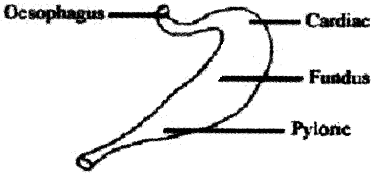
Question 2.
A 15-year-old boy was admitted in a hospital with a severe case of stomach ulcer. At the end of various tests it is found that Mucus glands are absent. Do you agree with this? Justify your answer.
Answer:
Yes. Highly concentrated HCL is presented in gastric juice. Mucus from the mucus gland protect the epithelium lining of the stomach from the action of HCL. So the absence of mucus gland cause stomach ulcer.
Question 3.

- Name the process (a).
- Name the enzyme (b).
- Name the product (c).
Answer:
- (a) – bile salt – emulsification
- (b) – pancreatic lipase
- (c) – Glycerol
Question 4.
Distinguish between Renin and Rennin.
Answer:
1. Rennin: A proteolytic enzyme found in gastric juice of infants which helps in the digestion of milk proteins.
2. Renin: It is an enzyme releasing from JGA, when there is a fall in glomerular filtration rate. Renin converts angiotensinogen into antigotensin II and regulate urine formation.
Question 5.
Complete the passage.
Fatty acids and glycerol are first incorporated into small droplets called _______ which move into intestinal mucosa. They are reformed into very small _______ coated fat globules called _________ which are transported to the __________ in the villi.
Answer:
Fatty acids and glycerol are first incorporated into small droplets called micelles which move into intestinal mucosa. They have reformed into very small Protein coated fat globules called Chylomicrons which are transported to the lacteals in the villi.
Question 6.
- It is not necessary to produce amylase in an inactive form in our body, but it is not in the case of Trypsin.
- In certain circumstances, peptic ulcer are found on the gut wall.
Answer:
1. Proteins are body building molecules. If proteins digesting enzymes are secreted inactive forms, they would hydrolyse the cellular and extracellular proteins of the organism itself. So the protein-digesting enzyme trypsin is secreted in their inactive form.
2. Mucus and bicarbonates present in the gastric and intestinal secretion protects the gut wall from the action of HCL and protein-digesting enzymes. In the absence of mucus and bicarbonates, peptic ulcer are found on the gut wall.
Question 7.
Construct a flow chart showing the passage of food through the alimentary canal of man.
Answer:
Mouth → Pharynx → Oesophagus → Stomach → Small intestine → Large intestine → Rectum → Anus.
Question 8.
Differentiate between Serosa and Lumen.
Answer:
The outermost layer of the wall of alimentary canal is called serosa. The inner hollow space in the alimentary canal is called lumen.
Question 9.
Find the odd one out and justify your answer.
Salivary gland, milk gland, gastric gland, thyroid gland.
Answer:
Thyroid gland. Thyroid gland is an endocrine gland. All others are exocrine gland.
Question 10.
Give below in bracket are the names of some digestive enzymes group them into A – Gastric, B – Pancreatic and C – Intestinal (Trypsin, Dipeptidase, Rennin, Maltase, Pepsin, Chymotrypsin, Nuclease, Amylase)
Answer:

Question 11.
Ramu ate boiled rice, what are the changes that it undergoes before being absorbed in the small intestine.
Answer:
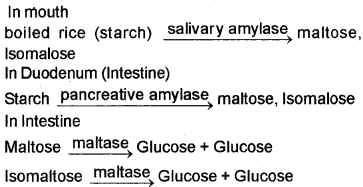
Question 12.
The dental formula of human is represented as \(i \frac{2}{2}\), \(\mathrm{C} \frac{1}{1}, \mathrm{Pm} \frac{2}{2}, \mathrm{m} \frac{3}{3}\). What do i, c, pm, m indicate?
Answer:
i – Incisors, c-Canines, pm – Premolars, m – Molars
Question 13.
Describe the Diphyodont and Thecodont characteristics of human dentition.
Answer:
1. Thecodont: It is a dentition in which the teeth are placed in the sockets of jawbones.
2. Diphyodont: It is a dentition in which the teeth appear twice in the lifetime of man. They are milk teeth and permanent teeth.
Question 14.
Observe the figure given below and answer the following questions.

- ‘x’ is a substance needed for digestion. What is the function of ‘x’?
- Name the gastrointestinal hormone responsible for the contraction of gall bladder to release ‘x’.
Answer:
- Bile – emulsification
- Cholecystokinin
Question 15.
Given below are the layers of human gut. Write a flow chart from inner region.
Serosa, mucosa, muscularis, submucosa
Answer:
Mucosa → Submucosa → Muscularis → Serosa
Question 16.
After observing the model of the lumen of human intestine your friend said that “the villi projected into the lumen actually block the movement of food through the intestine, if the villi are absent food can easily pass through the intestine.” How will you respond to this comment?
Answer:
Villi actually decrease the movement of chyme. The function of villi is to increase the surface area of the intestine for the absorption of digested nutrients.
Question 17.
Out of the following list, pick out the enzymes that take part in carbohydrate digestion.
Maltase, Lactase, Sucrase, Peptidase, Salivary amylase, Isomaltase.
Answer:
Maltase, Lactase, Sucrase, Salivary amylase, Isomaltase
Question 18.

- Mention the factor ‘x’ involved in the process.
- Identify the process and write its importance.
Answer:
- Bile salts
- Emulsification. The conversion large fat globules into tiny fat droplets is called emulsification. Bile salt helps emulsification. Emulsification increase the surface area for lipase action.
Question 19.
Below are given the names of the enzymes and their source of secretion. Match them.
| Enzymes | Source of secretion |
| Amylase | Stomach |
| Nuclease | Pancreas |
| Lipase | Small intestine |
| Protease | Salivary gland |
Answer:
| Enzymes | Source of secretion |
| Amylase | Salivary gland |
| Nuclease | Small intestine |
| Lipase | Pancreas |
| Protease | Stomach |
Question 20.
Strong acidic food in the stomach stimulate the secretion of secretin from duodenal wall.
- On which part of the digestive tract, secretion act?
- What is the role of secreting in digestion?
Answer:
- Secretin acts on exocrine part of pancreas.
- Secretin stimulates secretion of water and bicarbonate ions from pancreas. It protects the intestinal mucosa from acid as well as provide an alkaline medium for enzymatic activity in intestine.
Question 21.
Fatty chyme in duodenum decreases the speed of peristalsis. How the fatty chyme affects the speed of peristalsis?
Answer:
Fatty chyme in duodenum stimulate the release of GIP (Gastric Inhibitory Peptide Hormone). GIP produced by duodenum, inhibit gastric mobility.
Question 22.
Mention whether the following statements true or false. Justify your answer.
- Chymotrypsin is a fat digesting enzyme.
- Deglutition occurs in the intestine.
- Intestinal juice is also known as succus entericus.
- Function of enterokinase is to break peptide bond in proteins.
Answer:
- False – It is prominent protein-digesting enzyme present in pancreatic juice.
- False – It is the process of swallowing food from the pharynx to oesophagus.
- True – The collective secretion of intestinal gland is known as intestinal juice or succus entericus.
- False – Enteokinase present in succus entericus activates the inactive trypsinogen into active trypsin.
Question 23.
The following diagram shows the action of protein digesting enzymes of pancreas.

(a) Label the number 1, 2 and 3.
(b) Trypsinogen and Chymotrypsinogen are proenzymes (inactive enzymes). Why do they being produced inactive?
Answer:
(a) Label the number 1, 2 and 3.
- Enterokinase
- Chymotrypsin
- Peptides
(b) Trypsin and Chymotrypsin are protein-digesting enzyme formed from their respective inactive forms at the time of digestion of the protein food. If they are available all time in active form, they would damage the intestinal wall.
Question 24.
The calorific value of respiratory substrates is different. Do you agree? Give reasons.
Answer:
Yes, The calorific values of carbohydrates, proteins, and fats are 4.1 kcal /g, 5.65 kcal /g, and 9.45 kcal /g, respectively.
Plus One Digestion and Absorption Three Mark Questions and Answers
Question 1.
Gastric glands are formed of three types of secretory cells. Name them and mention their function.
Answer:
- Mucous cell – Secrete mucus
- Chief cells – Secrete proteolytic enzyme Pepsin
- Parietal cells – secrete HCL
Question 2.
Observe the flow chart and answer the questions.
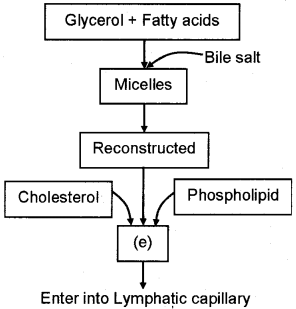
- What is the purpose of micelles in fat absorption?
- Identify ‘e’.
Answer:
1. Fatty acids and glycerol being insoluble, cannot be absorbed into the blood. They are first incorporated into small droplets called micelles which move into the intestinal mucosa. Micelles are formed with the help of bile salts and phospholipids,
2. Chylomicrons
Question 3.
Observe and analyse the graph and answer the following questions.

- Which region of the alimentary canal has maximum acidic pH?
- Why different regions of alimentary canal have different pH How this is maintained?
Answer:
1. Stomach
2. pH is the buccal cavity – in between 6.5 and 7, which is maintained by HCO3 – in the saliva. pH in the stomach is in between 1.8 and 2, which is maintained by HCL, secreted from gastric gland. The pH in the intestine is in between 8 and 9, which is maintained by HCO3– present in the bile and pancreatic juice.
Question 4.
Observe the given diagram.
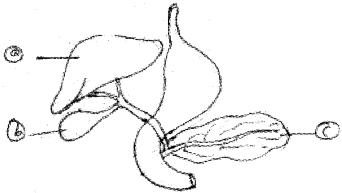
- Identify the parts a, b, c.
- If part ‘c’ has removed from a person due to a disease. What will be the changes in the digestive process of that person?
Answer:
1. a – Liver, b – Gall bladder, c – Pancreas
2. If the pancreas is totally removed from a person, he will die in a short period. Even if pancreas is only partially removed it will collapse the digestive process. In addition to this, the body cannot regulate the glucose level in blood.
The digestive juice secreted by pancreas contains three enzymes trypsin, amylase and lipase. Thus if pancreas is removed, the production of digestive enzyme will collapse.
Question 5.
Complete the flow chart.
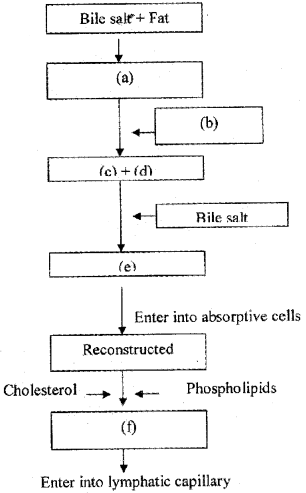
Answer:
(a) Emulsification
(b) Pancreatic lipase
(c) Fatty acids
(d) Glycerol
(e) Micelles
(f) Chylomicrons
Question 6.
Observe the diagram. Complete the boxes A, B and C appropriately.
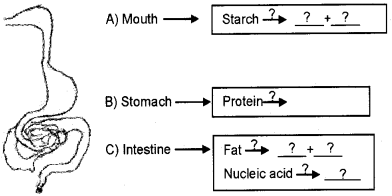
Answer:
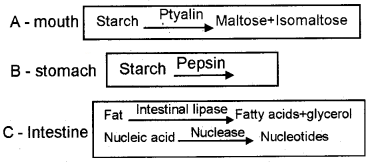
Question 7.
Observe the diagram.
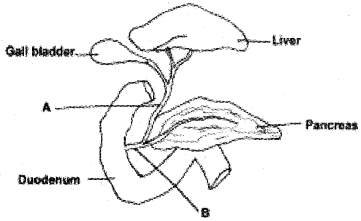
- Identify the ducts A and B.
- B is guarded by a sphincter in its opening to duodenum. Name it.
- Write any two functions of liver.
Answer:
- Ducts A and B are
- A – Common bile duct
- B – Hepato – pancreatic duct
- Sphincter of Oddi.
- Functions of liver are:
- Production and secretion of bile
- Production of albumin, Fibrinogen, Prothrombin, etc.
- Detoxification.
Question 8.
Given the diagram of intestinal villus.
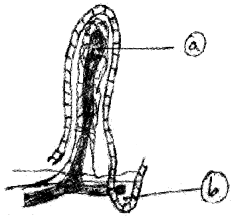
- Identify the part labelled as ‘a’ and ‘b’ in figure.
- Give the function of part ‘a’.
- What is the role of ‘b’ in digestion?
Answer:
- Identify the part labelled as ‘a’ and ‘b’ in figure
- ‘a’ Lacteal
- ‘b’ Crypts of Liberkuhn
- Absorption of fat and fat-soluble vitamins.
- Crypts of Lieberkuhn produce intestinal juice that helps indigestion.
Question 9.
Find the odd one out from each group and justify.
- Cardiac, Villi, Fundic, Pyloric
- Duodenum, Jejunum, ileum, villi
- Parotid, gastric, sublingual, submaxillary
Answer:
1. Villi:
Cardiac, fundic and pyloric are the three major parts of stomach. But villi are small finger like foldings in the intestine.
2. Villi:
Duodenum, jejunum and ileum are three regions of intestine but villi are small finger like foldings inside the intestine.
3. Gastric:
Parotid, Sublingual and submaxillary are three pairs of salivary gland produce saliva. But gastric gland is stomach gland produce gastric juice.
Plus One Digestion and Absorption NCERT Questions and Answers
Question 1.
Choose the correct answer among the following:
- Gastricjuice contains
- pepsin, lipase, and rennin
- trypsin, lipase, and rennin
- trypsin, pepsin, and lipase
- trypsin, pepsin, and rennin
- Succus entericus is the name given to
- a junction between ileum and large intestine
- intestinal juice
- swelling in the gut
- appendix
Answer:
- Gastricjuice contains
- Pepsin, Lipase and Rennin
- Succus entericus is the name given to
- Intestinal Juice
Question 2.
Match column I with and Rennin
Column I Column II
| Column I | Column II |
| (a) Bilirubin and biliverdin | (i) Parotid |
| (b) Hydrolysis of starch | (ii) Bile |
| (c) Digestion of fat | (iii) Lipases |
| (d) Salivary gland | (iv) Amylases |
Answer:
(a) – (ii), (b) – (iv), (c) – (iii), (d) – (i)
Question 3.
Why are villi present in the intestine and not in the stomach?
Answer:
The major portion of absorption takes palce in small intestines. In stomach simple sugars, water and alcohol absorbed. Villi are specialized projections in small intestine with large absorbent area. This facilities better absorbtion of complex molecules as well.
As food is fit to be absorbed only after complete digestion so villi’s turn comes after all the digestive processes are complete.
Question 4.
State the role pancreatic juice in digestion of proteins.
Answer:
The pancreatic juice contains inactive enzymes – trypsinogen, chymotrypsinogen, procarboxypetidases, amylases, lipases and nucleases. Trypsinogen is activated by an enzyme, enterokinase, secreted by the intestinal mucosa into active trypsin which in turn activities the other enzymes in the pancreatic juice.

Question 5.
Describe the process of digestion of protein in stomach.
Answer:
The proenzyme pepsinogen, on exposure to hydrochloric acid gets converted into the active enzyme pepsin, the proteolytic enzyme of the stomach. Pepsin converts proteins into proteoses and peptones (peptides).
![]()
Question 6.
Give the dental formula of human beings.
Answer:
Arrangement of teeth in each half of the upper and lower jaw in the order I, C, PM, M is represented by a dental formula which in human is as follows:
\(\frac{2123}{2123}\)
Question 7
Bile juice contains no digestive enzymes, yet it is important for digestion. Why?
Answer:
Bile emulsifies the fat making it easier digest by enzymes. Bile juice also helps inactivation of lipase, the enzyme which digests fat. Additionally, bile converts the acidic chyme to alkaline so that other enzymes can work on food.
Question 8.
Describe the digestive role of chymotrypsin. Which two other digestive enzymes of the same category are secreted by its source gland?
Answer:
Chymotrypsin digests proteins and converts it into dipeptides. Other digestive enzymes of the same category are Trypsin and Carboxypeptidase and they perform similar function.
Question 9.
Discuss the main steps in the digestion of proteins as the food passes through different parts of the alimentary canal.
Answer:
In the stomach the proenzyme pepsinogen gets converted into pepsin which acts on protein to convert it into peptone.
![]()
In small intestine enzymes Chymotrypsin, trypsin and carboxypeptdase do the rest of the digestion of protein.

Question 10.
Explain the term thecodont and diphyodont.
Answer:
Thecodont. In human beings, each tooth is embedded in a socket of the jaw bone. This type of attachment is called thecodont.
Diphyodont. The majority of mammals including human beings form two sets of teeth during their life, a set of temporary milk or deciduous teeth replaced by a set of permanent or adult teeth. This type of dentition is called diphyodont.
Question 11.
Name different types of teeth and their number in an adult human.
Answer:
An adult human has 32 permanent teeth which are four different types (Heterodont dentition)
Plus One Digestion and Absorption Multiple Choice Questions and Answers
Question 1.
In the intestine, food materials are absorbed through
(a) villi
(b) sustentacular cells
(c) sub-mucosa
(d) gastric glands
Answer:
(a) villi
Question 2.
Diastema refers to
(a) gap between the teeth
(b) gap between tongue and teeth
(c) ciliary cells on alimentary wall
(d) cell lining along pharynx
Answer:
(a) gap between the teeth
Question 3.
Pylorus is present between
(a) small and large intestine
(b) pancreas and small intestine
(c) oesophagus and stomach
(d) stomach and duodenum
Answer:
(d) stomach and duodenum
Question 4.
Elephant tusks are
(a) molars
(b) canines
(c) incisors
(d) premolars
Answer:
(c) incisors
Question 5.
Which of the following cells produce HCL
(a) beta-cells
(b) alpha-cells
(c) Oxyntic cells
(d) Chief cells
Answer:
(c) Oxyntic cells
Question 6.
Most abundant mineral of animal body is
(a) iron
(b) sodium
(c) potassium
(d) calcium
Answer:
(d) calcium
Question 7.
Bile salts act as activator of which enzyme?
(a) Pepsinogen
(b) Trypsinogen
(c) Lipase
(d) Pancreatic amylase
Answer:
(c) Lipase
Question 8.
When breast feeding is replaced by less nutritive food low in proteins and calories; the infants below the age of one year are likely to suffer from
(a) marasmus
(b) rickets
(c) kwashiorkor
(d) pellagra
Answer:
(a) marasmus
Question 9.
Which one of the following pairs of food components in humans reaches the stomach totally undigested?
(a) protein and starch
(b) Starch and fat
(c) fat and cellulose
(d) Starch and cellulose
Answer:
(c) fat and cellulose
Question 10.
A young infant may be feeding entirely on mother’s milk, which is white in colour but the stools, which the infant passes out is quite yellowish. This yellow colour is due to
(a) intestinal juice
(b) bile pigments passed through bile juice
(c) undigested milk protein casein
(d) pancreaticjuice poured into duodenum
Answer:
(b) bile pigments passed through bile juice
Question 11.
Which one of the following statements is true regarding digestion and absorption of food in humans?
(a) Oxyntic cells in our stomach secrete the proenzyme pepsinogen
(b) Fructose and amino acids arc abosrbed through intestinal mucosa with the help of carrier ions like Na+
(c) Chylomicrons are small lipoprotein particles that are transported from intestine into blood capillaries
(d) About 60°o of starch is hydrolysed by salivary amylase in our mouth
Answer:
(c) Chylomicrons are small lipoprotein particles that are transported from intestine into blood capillaries
Question 12.
Secretin and cholecystokinin are digestive hormones. They are secreted in
(a) oesophagus
(b) ileum
(c) pancreas
(d) duodenum
Answer:
(d) duodenum
Question 13.
FAD is a coenzyme derived from
(a) riboflavin
(b) vitamin-B12
(c) thiamine
(d) niacin
Answer:
(b) vitamin-B12
Question 14.
The pH of the digestive juices within the human small intestine is between 7.5 and 8.5. This environment is slightly.
(a) basic
(b) acidic
(c) neutral
(d) None of these
Answer:
(a) basic
Question 15.
Lipids, which can be found in oil based salad dressings and ice cream, during digestion are splitted into
(a) fatty acids and glycerol
(b) glycerol and amino acids
(c) glucose and fatty acids
(d) glucose and amino acids
Answer:
(a) fatty acids and glycerol
Question 16.
Crypts of Leiberkuhn are involved in
(a) secretion of succus entericus
(b) secretion of rennin
(c) secretion of ptyalin
(d) digestion of food
Answer:
(a) secretion of succus entericus
Question 17.
Which of the following is an organic molecule needed by the body in small amounts?
(a) Protein
(b) Zinc
(c) Vitamin-C
(d) Monosaccharide
Answer:
(c) Vitamin-C
Question 18.
Which one is not true about vitamins?
(a) Vitamins are organic catalysts
(b) Vitamins are indispensable for life
(c) Vitamins act as a source of energy
(d) Tocopherol is anti-sterility vitamin
Answer:
(c) Vitamins act as a source of energy
Question 19.
The malnutrition disease in man is
(a) Cridu chat syndrome
(b) Klinefelter’s syndrome
(c) Potbelly syndrome
(d) Edward’s syndrome
Answer:
(c) Potbelly syndrome
Question 20.
The process of resynthesis of food materials from simpler food molecules is called
(a) biosynthesis
(b) catabolism
(c) absorption
(d) assimilation
Answer:
(a) biosynthesis
We hope the Kerala Plus One Zoology Chapter Wise Questions and Answers Chapter 5 Digestion and Absorptionhelp you. If you have any query regarding Kerala Plus One Zoology Chapter Wise Questions and Answers Chapter 5 Digestion and Absorption, drop a comment below and we will get back to you at the earliest.
